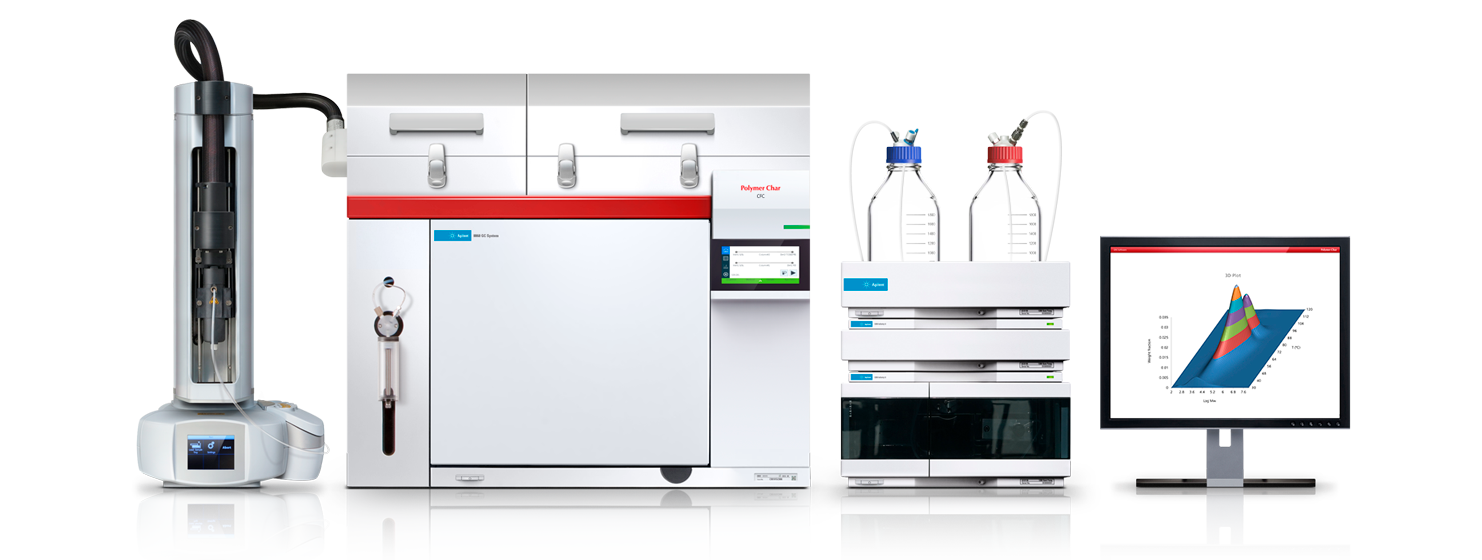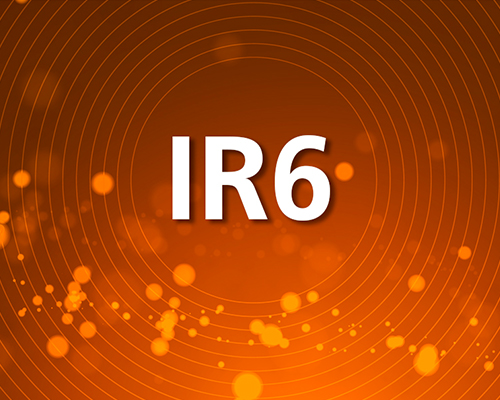CFC
Cross Fractionation Chromatography
An automated and benchtop cross-fractionation instrument to analyze the bivariate distribution in Polyolefins by TREF and GPC.

Cross Fractionation Chromatography
An automated and benchtop cross-fractionation instrument to analyze the bivariate distribution in Polyolefins by TREF and GPC.

Automated high-resolution Cross-Fractionation Chromatography (CFC) for Polyolefin characterization.
High-resolution cross-fractionation of polyolefins is now possible with Polymer Char’s fully-automated CFC instrument. Two-dimensional distribution interrelating molar mass and chemical composition is often required for a comprehensive characterization of complex materials. A complete cross fractionation is the only technique that determines this with no loss of information.
This compact and automated instrument fractionates the polymer according to composition through a Temperature Rising Elution Fractionation (TREF) process, while the resulting fractions are continuously injected into online GPC columns where a second fractionation, this time according to molar mass, is performed. Optionally, the TREF column can be replaced by a TGIC* column in order to separate by adsorption and reach the composition range of elastomer resins.
Polymer Char’s analytical CFC technology overcomes the difficulties of preparative fractionation methods, which are tedious and time-consuming. The full bivariate distribution is now measured in hours instead of days, with limited consumption of solvent, no manual intervention, and in an intrinsically safe setup.
The virtual instrumentation software allows for a flexible method configuration so that the analysis time and resolution can be optimized. A powerful and intuitive software package is available for data processing, calibration of columns, and graphical representation of distributions, allowing for different views of the data.
*Thermal Gradient Interaction Chromatography analysis of Polyolefins on a graphitized carbon column is a patented technology by DOW Chemical.
Click on each feature to display
Fully automation throughout the whole process, including vials filling and filtration. Therefore, there is no manual handling of solvents at any moment: once the vials containing the dry samples are placed on the autosampler room temperature tray, the instrument takes care of the rest of the steps involved, with no vial transfer. An in-line filter with backflush cleaning is incorporated, automating this step as well.
The CFC can incorporate the IR5 (high sensitivity) shown as the best option for polyolefin analysis, to measure both concentration and also composition (SCB/1000C). Or, it can also integrate the latest IR6, with same capabilities and features than IR5 detector and the additional capability of measuring carbonyls group in the band of 1740 cm-1.
The first separation step on the basis of composition can be performed by TREF for crystallizable polyolefin materials or by TGIC* for elastomer resins. Sub-ambient TREF operation (down to -15ºC) for low crystallinity samples. Flexible definition of a number of fractions and temperatures.
Sample dissolution time can be programmed individually for each vial, therefore, thermal degradation is minimized. Furthermore, a gentle shaking movement inside of the autosampler oven, helps in speeding up the dissolution process, without the shear stress due to magnetic stirring bars. In addition, oxygen can be removed from the vial by the automated nitrogen vials-purge system, in order to prevent oxidation of the dissolving polymer molecules.
GPC/SEC columns are fragile and need to be isolated from temperature changes. For this purpose, the CFC was designed with a dedicated heated columns box. The columns oven can remain at high temperature even when the rest of the instrument needs to be cooled down.
Analysis conditions are flexible so they can be specifically adapted to each sample requirements; software can manage all needed TREF fractions in temperature steps down to 1ºC resolution. Additionally, parameters related to the analytical process such as cooling and heating rates, volume, temperature and time among others can be set from the software analysis conditions screen for each run. As the set of conditions used for a certain run can be saved as a method file to be loaded at any time, the start of the analysis can be as simple as putting the samples into the vials in the autosampler room temperature tray and pressing the Start button in the software. Results can be reviewed and calculated when its analytical process is finished, even though the instrument is running other samples.
The CFC is designed to easily access to each component and facilitate the maintenance tasks when needed.
The CFC software allows using the instrument in standard GPC mode without any hardware modifications.
The following are the detectors available for CFC:

The IR6 Detector is the latest IR Detector developed by Polymer Char, with superior performance and sensitivity and the additional capability of measuring carbonyls group in the band of 1740 cm-1. We recommend the IR6 Detectors for users willing to analyze polyolefin type EVA, EBA, and others with carbonyls group present in the IR band above.
The CFC Virtual Instrumentation Software controls the whole analytical process combining GPC and TREF techniques to obtain the bivariate distribution. The whole process is automated from the sample preparation to a final cleaning of lines and columns, therefore, there is no solvent handling and when the instrument finishes the analysis, it is ready to start a new run.
Analysis conditions are flexible so they can be specifically adapted to each sample requirements; software can manage all needed TREF fractions in temperature steps down to 1ºC resolution. Additionally, parameters related to the analytical process such as cooling and heating rates, volume, temperature and time among others can be set from the software analysis conditions screen for each run.
As the set of conditions used for a certain run can be saved as a method file to be loaded at any time, the start of the analysis can be as simple as putting the samples into the vials in the autosampler room temperature tray and pressing the Start button in the software.
The results can be reviewed and calculated when its analytical process is finished, even though the instrument is running other samples.
The CFC Software includes a powerful calculations package, capable of obtaining directly the 3-dimensional graph to study the interdependence of the Molar Mass and the Chemical Composition Distribution of each sample. In addition to the 3D plot, the GPC and TREF recovered profiles are calculated too. Molar mass average values for each TREF fraction are provided as well.
Analyzed samples can be reviewed at any time thanks to the database installed in the CFC Software package and linked to the calculations screens. Raw and processed data can be exported to ASCII format.
To request a demo, please contact us
Read more about One Software
CFC instrument is a fully automated analytical scale instrument to obtain the bivariate distribution of polyolefins in composition and molar mass. Three dimensional distribution relating molar mass and composition variables is often required for comprehensive characterization of complex materials, and complete cross-fractionation is the only technique which determines it with no loss of information.
This compact automated instrument fractionates the polymer according to crystallinity, following a TREF process (Temperature Rising Elution Fractionation), meanwhile the resulting fractions are continuously injected towards online GPC columns where a second fractionation, this time according to molar mass, is performed.
Polymer Char’s analytical CFC technology overcomes the difficulties of preparative fractionation methods which are tedious and time consuming. The full bivariate distribution is now measured in hours instead of days, with limited solvent consumption and no manual intervention, in an intrinsically safe setup.
Absolutely, because the combination also provides the interdependence between composition and molar mass. Not every resin needs this, however. For homopolymer PP or PE, GPC alone is enough, and for simple PE/PP copolymers CCD alone may be enough. CFC testing provides the full picture of more complex resins.
CFC is an analytical instrument designed to obtain the bivariate distribution in a three dimensional plot as well as recovered GPC and TREF profiles in a fully automated way, but it doesn’t provide any physical fraction. It might be possible to collect the TREF fractions as they elute from the columns, however the instrument is not optimized for this and the process is not automated. Please refer to the PREP mc2 for an automated fractionation instrument.
Up to 42 samples can be run with no supervision required, in about 12 hours per sample under good resolution conditions (>20 temperature fractions).
The standard amount used in CFC analysis is around 16 - 32 mg per sample.
1,2,4-Trichlorobenzene (TCB) and Orto-Dichlorobenzene (oDCB) are the most used solvents. To use other solvents please consult Polymer Char first.
No samples preparation is required by the user but weighing the dry samples and putting them inside of the vials in the autosampler tray. The rest of the steps are performed by the instrument automatically: filling, dissolution, TREF column loading, crystallization, elution, GPC columns injection, final cleaning, etc. Therefore, when a run is finished, another one can be started immediately.
Solvents don’t need to be handled at any time; the whole process is fully automated and the instrument is in charge of all the needed steps: filling, dissolution, TREF column loading, crystallization, elution, GPC columns injection, final cleaning, etc.
LLDPE, LDPE, HDPE, PP, E-P copolymers, multicatalyst reactor resins, and any semicrystalline polymer soluble in TCB or oDCB, giving response to C-H absorption.
CFC incorporates an infrared detector to measure the concentration of each fraction going out of the TREF column and then being injected into the GPC columns. The CFC can integrate either an IR5 detector recommended for its outstanding sensitivity both in concentration and in composition, or the latest IR6 which in addition to being alto highly sensitive, it offers the measurement of the carbonyls group in the band of 1740 cm-1.
CFC instrument incorporates a TREF column, which is located in the main oven where the temperature ramps can be performed. GPC columns connection will be done in the instrument top oven, always kept at a constant high temperature for its optimum preservation.
After each sample analysis, data can already be accessed and calculated through the CFC software database. A powerful calculations package is included, capable of obtaining directly the 3 dimensional plot for the study of the interdependence of the Molecular Weight and the Chemical Composition Distribution of each sample. In addition to the 3D plot, the GPC and TREF recovered profiles are calculated too.
Thank you for your interest. If you would like to receive more information or want to request a quotation please complete this form.
This site uses cookies to give you a better browsing experience. If you continue
browsing this site we understand that you accept our use of cookies.
For more information,
please visit our Cookies Policy. You can configure which
cookies you accept by ticking the next options: